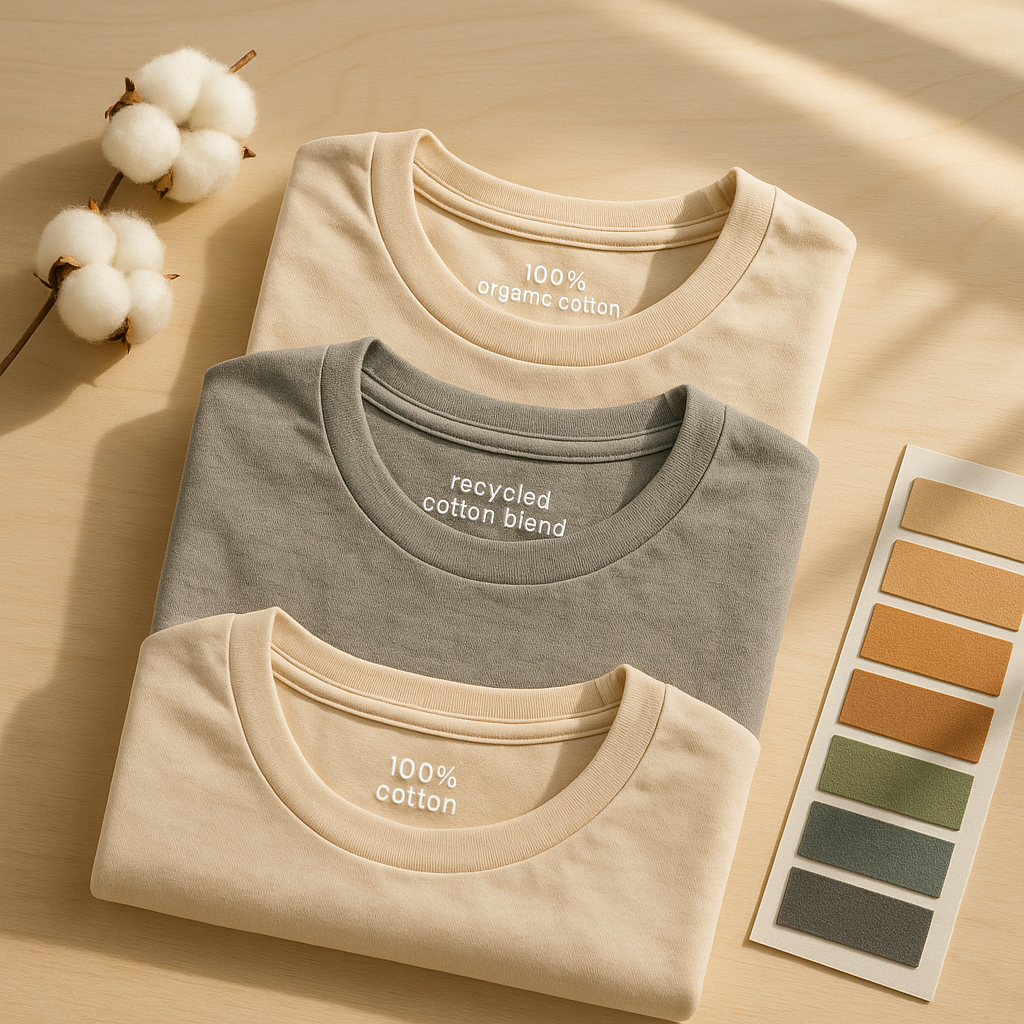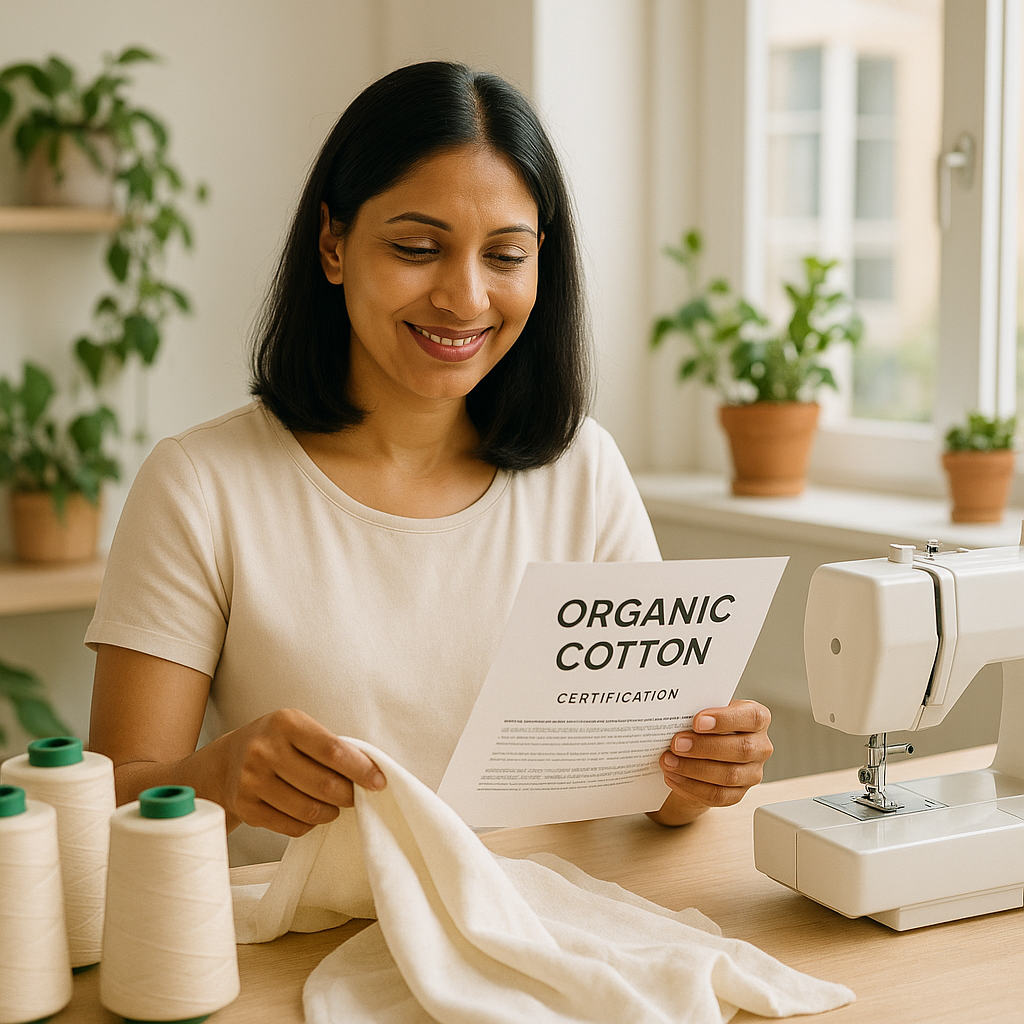Organic & Recycled Cotton Apparel and Print-on-Demand: The Ultimate Guide
The apparel industry is experiencing a significant shift toward sustainability, with organic and recycled cotton becoming vital materials for conscious brands. As consumers increasingly prioritize environmental and ethical considerations, print-on-demand businesses have a unique opportunity to lead in sustainable fashion. This intersection of eco-friendly materials and made-to-order production creates a powerful combination that reduces waste while meeting modern market demands.
You could see this same philosophy applied when redefining sustainability with made-to-order phone cases – the principles remain consistent across sustainable product categories.
In this comprehensive guide, we'll explore the essential differences between fabric types, examine the compelling reasons to choose sustainable materials, navigate certifications, highlight exceptional products, and provide actionable steps to launch your own eco-conscious print-on-demand line.
Understanding organic and recycled cotton: key differences and certifications
Before diving into print-on-demand applications, it's crucial to understand what makes these sustainable textiles fundamentally different from conventional options.
Organic cotton is grown without synthetic pesticides, fertilizers, or genetically modified seeds. This cultivation method preserves soil health, protects biodiversity, and eliminates harmful chemical runoff. The farming practices focus on crop rotation, natural pest management, and reduced water usage. Organic cotton farming typically uses 88% less water and 62% less energy than conventional methods, creating a significantly reduced environmental footprint.
Recycled cotton, meanwhile, comes from post-industrial or post-consumer waste. Post-industrial recycled cotton utilizes manufacturing scraps that would otherwise be discarded. Post-consumer recycled cotton transforms discarded garments into new fabrics through mechanical or chemical processes. This approach diverts textile waste from landfills and reduces the need for virgin materials, lowering the overall environmental impact of clothing production.
Conventional cotton, by contrast, relies heavily on synthetic chemicals, accounts for nearly 16% of global insecticide use, and requires intensive irrigation. The environmental toll includes soil degradation, water pollution, and health risks for farming communities exposed to agricultural chemicals.
Certifications to look for
When sourcing sustainable textiles for print-on-demand, legitimate certifications provide essential verification. Here's what to know about the most important standards:
- Global Organic Textile Standard (GOTS) – The gold standard for organic textiles, ensuring organic cultivation and ethical processing throughout the supply chain. GOTS certification prohibits hazardous chemicals and mandates wastewater treatment in manufacturing.
- Organic Content Standard (OCS) – Verifies the presence and amount of organic material in products with third-party certification, though it doesn't address processing chemicals or social criteria like GOTS does.
- OEKO-TEX Standard 100 – Confirms textiles are free from harmful substances, ensuring they're safe for human use, though it doesn't specifically address organic cultivation.
- Global Recycled Standard (GRS) – Verifies recycled content and tracks responsible social, environmental and chemical practices in production.
- Fair Wear Foundation – Focuses on labor conditions and worker rights throughout the textile supply chain.
- PETA-Approved Vegan – Guarantees products contain no animal-derived components and weren't tested on animals.
These certifications provide credibility and transparency, critical factors for environmentally conscious consumers seeking genuine sustainable options. For print-on-demand businesses, choosing certified items builds trust while demonstrating commitment to verified supply chain practices. Check out more eco-tips and sustainable product insights to deepen your understanding of sustainable business practices.
Why choose organic and recycled cotton in print on demand?
Incorporating sustainable textiles into your print-on-demand business isn't just environmentally responsible—it's increasingly becoming a strategic advantage in today's competitive marketplace.
Market trends clearly demonstrate growing consumer preference for ethical brands. Research shows that 73% of global consumers would definitely or probably change their consumption habits to reduce environmental impact. This shift creates substantial opportunities for sustainable print-on-demand businesses to capture market share from less environmentally conscious competitors.
The appeal extends beyond environmental benefits. Organic cotton typically produces softer, more comfortable garments with superior durability compared to conventional options. These quality differences translate directly to customer satisfaction, reduced returns, and stronger brand loyalty—all critical factors for print-on-demand success.
While sustainable materials often carry higher initial costs, they also enable premium positioning and pricing. Many successful eco-friendly print-on-demand businesses report higher profit margins despite increased material costs, as customers willingly pay more for products aligned with their values. Our premium designs made with 100% organic cotton demonstrate how quality materials elevate the final product.
Common misconceptions about sustainable materials include concerns about print quality and color vibrancy. However, advancements in both fabric formulations and printing technology have largely eliminated these issues. Modern organic and recycled cotton products accept prints beautifully, with excellent color retention and durability through washing.
Perhaps most importantly, choosing sustainable materials builds authentic brand identity. In an increasingly crowded marketplace, genuine environmental commitment provides meaningful differentiation that resonates with conscious consumers looking for brands that share their values.
Core benefits and challenges of sustainable cotton apparel
Understanding the specific advantages and realistic trade-offs of eco-friendly materials helps build a sustainable print-on-demand business with transparent customer communication.
Superior fabric quality represents one of the most tangible benefits. Organic cotton typically features longer fibers, creating smoother, more durable textiles that resist pilling. Ringspun organic cotton—made by twisting fibers into fine, strong strands—produces exceptionally soft fabrics perfect for premium apparel. These quality differences translate to enhanced print surfaces, better garment drape, and improved customer satisfaction with the final product.
The environmental benefits are equally compelling. Organic cotton cultivation uses approximately 91% less water than conventional farming while eliminating toxic pesticides that contaminate watersheds. Recycled cotton production requires significantly less energy and water compared to virgin materials, diverting textile waste from landfills where it would otherwise generate methane emissions.
Health considerations also favor sustainable options. Conventional cotton processing introduces numerous potentially harmful chemicals, including formaldehyde, heavy metals, chlorine bleach, and AZO dyes—some of which may remain in finished garments. Certified organic and recycled cotton undergoes stricter chemical controls, reducing exposure risks for both workers and end users.
Printing results on sustainable fabrics match or exceed conventional materials when properly executed. The natural fibers provide excellent ink absorption for vibrant, long-lasting designs. Digital direct-to-garment printing particularly excels on premium organic textiles, with reduced dot gain and improved color clarity compared to lower-quality conventional fabrics.
Honest assessment requires acknowledging certain challenges. Sustainable materials typically cost 15-30% more than conventional alternatives, necessitating either higher retail pricing or adjusted margin expectations. Supply chain complexity increases with certification requirements and more limited supplier options. Seasonal availability fluctuations may affect certain products, requiring flexible inventory planning.
Despite these challenges, the benefits overwhelmingly support the business case for sustainable materials in print-on-demand operations. As one industry expert noted, "The quality difference alone justifies the switch to organic cotton, with environmental benefits providing additional value that resonates strongly with today's consumers." By championing sustainability with made-to-order innovation, businesses can position themselves at the forefront of industry transformation.
Social & ethical impact: beyond the environment
The benefits of sustainable cotton extend far beyond environmental considerations. Conventional cotton production often involves significant human costs, including pesticide exposure, unsafe working conditions, and inadequate compensation. Choosing certified organic and fairly traded materials directly supports safer working environments, fair wages, and community development.
GOTS certification requires adherence to International Labour Organization standards, prohibiting forced labor and guaranteeing reasonable working hours and safe conditions.
Fair Wear Foundation partners ensure worker representation and fair compensation throughout production. These social standards create positive ripple effects in farming communities, improving education access, healthcare outcomes, and economic stability.
For print-on-demand businesses, these social benefits provide compelling storytelling opportunities that resonate with values-driven consumers. Transparent communication about both environmental and social impacts builds authentic brand identity while supporting meaningful industry transformation.
Best organic and recycled cotton products for print-on-demand
Selecting the right sustainable products forms the foundation of an eco-friendly print-on-demand business. The following options combine quality, printability, and genuine environmental credentials.
Stanley/Stella leads the premium sustainable apparel sector with exceptional organic cotton basics.
Their Creator STTU755 unisex t-shirt features 100% GOTS-certified organic cotton in a 180 gsm weight that provides ideal print surface while maintaining excellent drape and comfort. The Stella Amazes STTW040 women's tee offers a tailored silhouette with the same premium organic materials. Both products feature tearaway labels for easy rebranding and consistent quality that justifies their higher price point.
For mid-range options, Bella+Canvas offers their 3001CVC in a recycled cotton blend that maintains exceptional printability while incorporating post-industrial recycled content. Their softer hand feel and contemporary fit appeal to fashion-conscious consumers. Continental Clothing's EP01 unisex t-shirt provides another excellent mid-tier option, with GOTS certification and carbon-neutral manufacturing.
Budget-friendly options include Gildan's 2000 in their Eco line, featuring recycled cotton content at a price point accessible to new businesses. While not fully organic, these represent a significant improvement over conventional options for price-sensitive markets.
Beyond t-shirts, sustainable accessories provide excellent print-on-demand opportunities. EarthPositive's EP70 tote bag features heavy-duty 100% organic cotton canvas, perfect for bold designs with excellent durability. You might also consider our sustainable organic cotton tote as an example of how these materials perform in real-world applications.
Mantis World offers exceptional organic cotton hoodies and sweatshirts in their Superstar line, providing premium printable surfaces for cold-weather apparel. Their commitment to transparency includes publicly available factory audit reports, reinforcing ethical manufacturing claims.
When evaluating options, prioritize products with clear certification documentation, consistent sizing across batches, and proven printing performance. Request sample products before committing to large inventory investments, testing print adhesion, wash durability, and general quality. Remember that truly sustainable products should maintain their quality through multiple washes and extended use—fast-fashion durability undermines environmental benefits regardless of material sourcing.
Launching your own sustainable POD line: step-by-step
Building a successful eco-friendly print-on-demand business requires thoughtful planning and execution. Follow these steps to create a brand that resonates with environmentally conscious consumers.
Begin with thorough market research to identify specific niches within the sustainable fashion space. Examine competitor positioning, price points, and messaging to find opportunities for meaningful differentiation. Consider specialized segments like vegan athletic wear, eco-friendly workplace essentials, or carbon-neutral casual fashion rather than competing broadly against established players.
Select print-on-demand partners with demonstrated environmental commitments. Evaluate their production processes, packaging materials, printing technologies, and shipping options. Leading sustainable POD providers utilize water-based inks, energy-efficient printing, plastic-free packaging, and carbon offset programs. Request documentation of these practices rather than relying on marketing claims.
Develop a cohesive product catalog around specific themes or values. Limited, thoughtfully curated collections generally outperform scattered product offerings. Consider complementary items that work together as bundles or collections—for example, matching organic t-shirts, totes, and hats with consistent design elements.
Craft transparent, educational product descriptions that clearly communicate both environmental benefits and product features. Highlight specific certifications, material composition, and production methods. Avoid vague "eco-friendly" claims in favor of specific, verifiable statements about environmental impact. Include care instructions that extend product lifespan, reinforcing sustainability messaging.
Price products strategically, recognizing that sustainable materials justify premium positioning. Most successful eco-conscious brands maintain prices 15-30% above conventional alternatives, communicating value through quality and ethics rather than competing on price alone. Consider implementing a transparent pricing model that explains material and production costs to reinforce authentic sustainability commitment.
Develop marketing strategies that emphasize both product quality and environmental impact. Create content educating consumers about sustainable materials, certification meanings, and proper garment care. Partner with aligned influencers and organizations to build credibility and reach. Consider our organic print-on-demand collection for inspiration in sustainable product presentation.
Implement sustainability throughout operations beyond products alone. Utilize digital receipts, minimize packaging, select carbon-neutral shipping options, and consider impact offsetting programs. These operational choices reinforce brand values while reducing overall environmental footprint.
Measure and communicate impact metrics when possible. Track resources saved, waste diverted, or ethical labor supported through your business activities. Sharing these metrics builds credibility while demonstrating genuine commitment beyond marketing claims. Consider periodic impact reports highlighting environmental and social contributions as your business grows.
Sustainable business growth requires continual evolution. Regularly reassess materials, processes, and partnerships to identify improvement opportunities. Sustainability represents a journey rather than a destination, with ongoing innovation driving both environmental benefit and business differentiation.
Conclusion
The convergence of organic and recycled cotton with print-on-demand technology represents a powerful opportunity for forward-thinking entrepreneurs and brands. By embracing sustainable materials, businesses can reduce environmental impact while meeting growing consumer demand for responsible fashion options. The on-demand production model inherently reduces waste by eliminating unsold inventory, while sustainable materials minimize environmental impact throughout the supply chain.
Quality differences in organic and recycled materials deliver tangible benefits to consumers through softer, more durable garments that maintain their appearance through extended use. These quality advantages translate to stronger customer satisfaction and brand loyalty, supporting business growth through repeat purchases and word-of-mouth recommendations.
While implementing sustainable practices requires thoughtful planning and sometimes higher initial investment, the business case remains compelling. Premium positioning, authentic brand storytelling, and alignment with growing consumer values create sustainable competitive advantage in an increasingly crowded marketplace.
As you consider launching or expanding a print-on-demand business, remember that true sustainability encompasses materials, production methods, business operations, and transparent communication. By making conscious choices throughout your business model, you can create fashion that looks good, feels good, and does good—a powerful combination in today's market.
The future of fashion lies in responsible innovation that balances environmental, social, and economic considerations. Print-on-demand sustainable apparel represents an important step toward that vision, allowing businesses of all sizes to participate in fashion industry transformation while building successful, purpose-driven brands.
Frequently asked questions
Is organic cotton really better for the environment?
Yes—organic cotton eliminates harmful pesticides and relies on sustainable farming, dramatically reducing pollution and water use.
Can you print high-quality designs on recycled or organic cotton shirts?
Absolutely! Modern organic and recycled cotton t-shirts are engineered for crisp, long-lasting digital prints with vibrant colors.
What certifications matter most for eco-friendly apparel?
Look for GOTS (Global Organic Textile Standard), OEKO-TEX, OCS 100, Fair Wear Foundation, and PETA-approved Vegan labels.
Is print-on-demand truly sustainable?
POD reduces overproduction and inventory waste—especially when paired with organic or recycled materials. You can learn more about made-to-order sustainability in our post on championing sustainability with made-to-order innovation.
What makes a sustainable print-on-demand line stand out to customers?
Transparent sourcing, certifications, clear eco messaging, and product quality all boost buyer trust and loyalty.



























